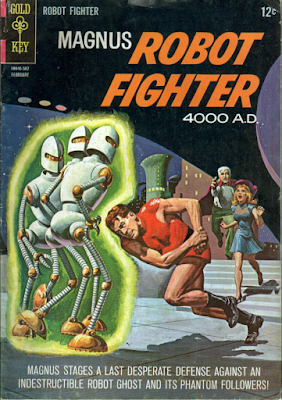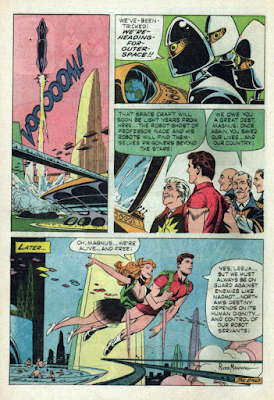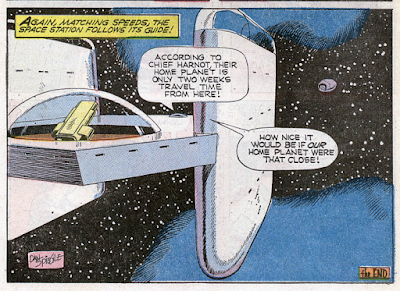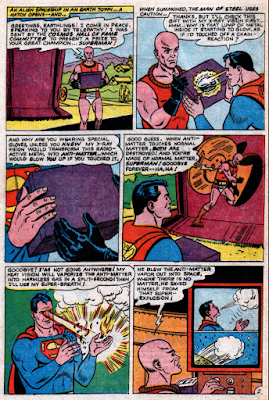A few days ago, I received a pack of DVDs from an online seller that made me delirious with joy. The DVDs contained scanned comic books from the 60s and 70s (the so-called Silver Age), and among these were many that I had owned when I was a child.
Going through this set gave me many nostalgic moments, and I realised that my very way of thinking has been profoundly altered by their influence.
My favourite comics were not of the light, ha-ha funny kind. Many of my friends enjoyed reading Archie, Richie Rich, Donald Duck, Sad Sack, and the like. My favourites were Science Fiction and Superhero comics.
Being middle-class, my parents couldn't afford to indulge my every request, but they did occasionally buy me the comics I asked for, and these gave me so much pleasure that I read them over and over, memorising the dialogues even when they made little sense at the time.
In those days, Indian schoolteachers were strongly discouraging of comics. The received wisdom was that "comics spoil your English". Our teachers wanted us to read classics in book form instead. But I maintain that I learnt a lot more from comics. I not only built up an impressive vocabulary at a young age, but also learnt a number of scientific concepts long before they made their formal appearance in my classroom. That's why I would encourage all parents to give their children Science Fiction comics from a very early age, and indulge them in their fantasies. My father was quite indulgent, and often laughed along as I made up my own scenarios and dialogues using scientific and pseudo-scientific terminology.
Here are some examples of what I read:
Doctor Solar - Man of the Atom
One of my first SF comics, if not the very first. This was published in 1967, and I got my hands on it sometime in 1969, I believe. I was six years old then.
In retrospect, the Doctor Solar comics were a bit amateurish, because the hero's powers were not well-defined, and he could apparently do anything. Still, this comic familiarised me with a number of scientific terms that I would learn the meanings of only much later.
For a 6 year old, my vocabulary began to expand in strange ways.
"Outer Space" became a common word in my vocabulary, and this was not the only comic to use it
"Atomic radar vision"? Oh, well.
Germs, viruses, contaminated
An isotope of Uranium
The speed of light
Vaporized lead, orbits, spores
Atomic artillery, laser beams, matter, energy
Short-circuit
Molecules, absolute zero
High-frequency sound, airless void
"No sound can pass through an airless void"
Expansion can explode vessels like steam overloads a boiler
Cosmic storm
Looking back on this five decades later, I'm in awe of how much this one issue taught me. I was mesmerised by the story, the superhero and his powers, and all the scientific terms that were casually thrown about. I think this was the comic that laid the foundation for my later career choices in favour of engineering and computer technology, and my lifelong interest in science in general.
Magnus Robot Fighter
I had two comics of Magnus Robot Fighter, and both were mind-blowing. Looking back now, I realise that it was Russ Manning's visionary artwork that brought a future world to life in such breathtaking and convincing detail.
Bunda the Great
This was a story about a robot that grows too big for its own boots, even demanding to be treated as a god until Magnus brings it down.
As I said before, the artwork in this series was simply spectacular.
The drawings were so detailed and consistent that one could form a mental picture of the future society called "North Am".
Magnus defeats the mighty Bunda that weighs four tons. It crashes to its death because it does not contain anti-gravity units!
There is an element of religion here, and perhaps my first exposure to the idea that religion is just quackery.
The birth of a new religion...
...and its debunking by science.
Robot Ghost
Another beautiful Magnus story was of a group of invincible robots surrounded by a force field, robots built by a scientist to exact revenge on society after his death. The robot Nadmot filled me with delicious chills. It became my favourite villain for a while. The only way to defeat it was by trickery.
Note the beauty of Russ Manning's artwork, and the imagery it conjures up.
Guard-robs and riot-robs
The guard-robs prove ineffective against the evil robots' force-field
I had memorised this sentence so well that older kids in my school bus would ask 7-year-old me to recite it for their amusement: "Even Magnus's steel-smashing strength is unable to penetrate the mysterious barrier that veils the evil robots"
Ultimately, Magnus fools the evil robots with an illusion...
...and sends them off on a one-way trip into deep space. Once again, look at Russ Manning's depiction of the world of the future.
Space Family Robinson - Lost in Space
Much later, I learnt that this was a futuristic take on the classic adventure story "Swiss Family Robinson". The issue I had was called "Attack of the Plant Creatures".
Once again, the artwork in this comic conjured up a very romantic image, this time of space travel in general.
How lovely to be able to live in a home like this!
Ooh, laser pistols! And they can burn holes through a ship's casing unless you set them for close range!
The notion of vacuum has never been explained more graphically
How nice it would be to live in a space station! Sigh.
Voyage to the Bottom of the Sea
Closer home, the adventures of a nuclear submarine called the Seaview captured my imagination. I had two comics in this series. The first was about an intelligent dolphin called Star that organised the creatures of the sea against humans.
The Emperor of the Oceans
The artwork here was fabulous, too, and it gave me chills.
It was scary to see whales hijacking a submarine. The reddish light in the submarine's cabin gave it an atmosphere of crisis.
The Life and Death of the Seaview
This issue was even more dramatic. It introduced something called the Moho fluid, believed to be responsible for all life on earth. But a subterranean explosion opens up an underwater reservoir of the Moho, and the Seaview is forced at one point to fill its ballast tanks with the fluid. That turns the Seaview itself into a living creature.
The artwork in this issue was nothing short of magnificent. I was by turns fascinated and terrified by the underwater scenes it depicted.
I wouldn't want to be caught in something like this!
Not to mention being inside something like this!
This was one of the most thrilling scenes for me - how the Seaview was taken back
And the thrilling race back to the surface, because there's a time bomb that will seal them in along with the Moho fluid if they don't make it out in time!
Admiral Nelson of the Seaview was one of my early heroes, and it gave me a thrill later on in history class when I learnt about the real Admiral Horatio Nelson
And the mandatory philosophy lesson right at the end.
I simply loved submarines, thanks to the adventures of the Seaview
Superman
The School for Superman Assassins
One of my aunts bought this issue for me, and I remember this with gratitude.
Superhero comics were a slightly different experience from Science Fiction comics, but there was still a great element of science fiction in them.
In those early issues, it was necessary to remind readers that Superman's secret identity was Clark Kent.
Since this was my very first Superman comic, I certainly needed to be told that.
This was my first introduction to the notion of matter and anti-matter...
...and to the notion of time travel. I would read HG Wells's classic 'The Time Machine' only much later.
"Friction causes heat" - I learnt this from a Superman comic long before I heard about it in any science class
In-between some humour, a number of concepts were taught
Again, long before I learnt Newton's Third Law in a classroom, Superman had already taught me that "the physics principle behind rocketry is reaction"
This is just a sample of what my eclectic childhood was like. I grew up on a university campus, with academics for parents. I would never trade my childhood for anyone else's. And a large part of the magic of that childhood was thanks to the wonderful Science Fiction and Superhero comics I grew up with.
Once again, I would exhort parents to give their children the gift of this magic. Five decades later, I'm still tingling with excitement to re-read these beloved stories!

















































